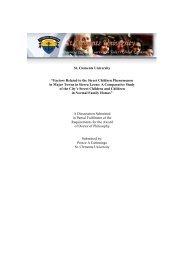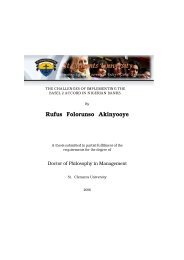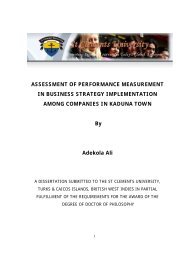The role of informal microfinance institutions in saving
The role of informal microfinance institutions in saving
The role of informal microfinance institutions in saving
You also want an ePaper? Increase the reach of your titles
YUMPU automatically turns print PDFs into web optimized ePapers that Google loves.
Rural Agricultural clusters<br />
Agriculture is still a backbone <strong>of</strong> our economy. It contributes more than 50% <strong>of</strong> the<br />
country’s GDP and accounts for about 60% <strong>of</strong> the country’s foreign earn<strong>in</strong>gs.<br />
Despite existence <strong>of</strong> many opportunities for commercial agriculture <strong>in</strong> rural areas,<br />
the barriers are just too daunt<strong>in</strong>g for a significant change <strong>in</strong> commercialization <strong>of</strong><br />
agriculture to take place <strong>in</strong> the foreseeable future. <strong>The</strong>re is need for a radical scheme<br />
to make agriculture viable option, even for graduates <strong>of</strong> colleges. It is recommended<br />
to establish agricultural clusters cm <strong>in</strong>cubators to nurture and produce commercial<br />
farmers. <strong>The</strong> proposed scheme could work as follows. Incubator promoters would<br />
identify large tracks <strong>of</strong> accessible land suitable for pre-determ<strong>in</strong>ed types <strong>of</strong> crops or<br />
livestock for which existence <strong>of</strong> adequate long-term demand will have to be<br />
ascerta<strong>in</strong>ed <strong>in</strong> advance.<br />
Young graduates <strong>in</strong>terested <strong>in</strong> develop<strong>in</strong>g a career <strong>in</strong> commercial agriculture will be<br />
<strong>in</strong>vited to apply for the scheme. <strong>The</strong>ir <strong>in</strong>itial capital may be their labor or loans<br />
from the government or other <strong><strong>in</strong>stitutions</strong>. Towards the end <strong>of</strong> their <strong>in</strong>cubation,<br />
they will be allocated developed land where they will build their basic houses. After<br />
two or three years, the physical <strong>in</strong>cubator will relocate to another area, leav<strong>in</strong>g<br />
hundreds <strong>of</strong> people, each with a significant, productive piece <strong>of</strong> farm as a cluster.<br />
<strong>The</strong> <strong>in</strong>cubates could organize themselves <strong>in</strong>to a market<strong>in</strong>g co-operative and<br />
or/SACCOs, even before the <strong>in</strong>cubator relocates. <strong>The</strong>se <strong>in</strong>cubators can be seen as<br />
some form <strong>of</strong> agricultural tra<strong>in</strong><strong>in</strong>g colleges, with a bias <strong>in</strong> start<strong>in</strong>g and operat<strong>in</strong>g <strong>in</strong><br />
agri-bus<strong>in</strong>ess, rather than employment.<br />
<strong>The</strong>re could be many variations <strong>of</strong> this mode/idea. For example, <strong>in</strong>cubates may pay<br />
fees as they pay <strong>in</strong> colleges, or they could take a loan for <strong>in</strong>cubation and repay after<br />
graduation. Graduat<strong>in</strong>g <strong>in</strong>cubates may have the option <strong>of</strong> sell<strong>in</strong>g their farms to<br />
other people, or some farms so developed could be sold to <strong>in</strong>terested retir<strong>in</strong>g army<br />
or other retirees. It could also be for commercial animal husbandly, <strong>in</strong>clud<strong>in</strong>g<br />
ranch<strong>in</strong>g. <strong>The</strong> big advantage <strong>of</strong> this mode is that many <strong>of</strong> the constra<strong>in</strong>ts are<br />
simultaneously addressed. <strong>The</strong> programme can be funded <strong>in</strong> different ways and<br />
128
















